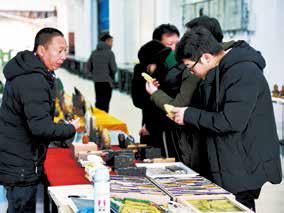Simply Stunning
2019-03-18HongXu
Hong Xu
Qingtian is the birthplace of Yang Zhonggui, a writer and specialist in the stone carving tradition of Qingtian. “Qingtian has been densely-populated for most of its long history. The countys long-time geographical isolation from the rest of the province and the country made the local culture and language very distinct, and as a result, fostered a unique emigrant tradition that started about 300 years ago. Many locals left their native land to make a better life, earning their first pot of gold by peddling “Qingtian stones” in foreign lands and seeing their entrepreneurial dream come true.”
It is no exaggeration to say the “Qingtian stone” is the cornerstone of the success stories of generations of Qingtiannese whose presence adds color and variety to their adopted countries and forever graces their hometown.
In the “information age” as it is today, culture serves as a most effective communication outlet. Ranking among “Chinas top four seal-making stones”, Qingtian Stone has long served as the calling card of the fine-quality art and culture of Qingtian, and boasts a well-established reputation among a truly global clientele. The beauty of Qingtian Stone has been shared at trade shows in the worlds most famous cities, such as Los Angeles, Milan, Paris, Madrid and Stockholm.

青田石雕作品。Two Qingtian stonecarving works
“Generations of stone-carving masters from Qingtian have contributed to the unique traits of this craftsmanship, through which the cultural magnificence of China can be better understood and appreciated by the world audience,” Dr Kevin Murray, Senior Vice-President of the World Crafts Council-Asia Pacific Region (WCC-APR) that forms the largest and most active part of the World Crafts Council (WCC), marveled at the stunning artistry from Qingtian at the “Belt-and-Road” Qingtian Stone-carving Fair held in Qingtian on December 13, 2018.
“I hope to see more communication and cooperation between the stone-carving artists from Qingtian and WCC in future,” said Kevin Murray at the fair.
“The stone-carving tradition of Qingtian dates back more than 1,700 years ago, serving as the ideal epitome of what is known as the ‘Qingtian spirit, and has been continuously enriched by the evolution of times. It is also a tangible embodiment of the enormous cultural significance of the implementation of ‘Belt-and-Road strategy initiated by China, and a cultural seeder that fosters international friendship.” In the eye of Wu Feifei, a member of the County Party Committee and Director of the Information Office of Qingtian, the time-tested craft is a perfect illustration of Chinese peoples relentless pursuit of an artsy lifestyle by incorporating art into everyday life and using the basic materials created by Mother Nature.
Stone carving works by artisans from Qingtian were used as a tribute in the Qing times of China. The Palace Museum in Beijing hosts a fine collection of 60 seal masterpieces made of Qingtian Stone. The glory of the craft made its full-scale comeback in the 1950s, thanks to the countrys determined action to salvage folk handicrafts from sinking into oblivion. The 1980s saw the craft thrive and blossom into a developmental peak that not only maintains its aesthetic traits and specialization but also meets the demands of a market-oriented society.
Rated as one of the “top 10 traditional industries in Zhejiang”, the craftsmanship ranks among Chinas first legion of national-level cultural heritages. The past four decades saw the renaissance of Qingtian stone-carving based on all-round support from the local government and the timely launch of the Qingtian Stone-carving Industrial Protection and Promotion Bureau at the beginning of the 21st century. A cycle of activities designed to promote Qingtian Stone-carving to a wider audience and prepare the craft as one of the candidates for the selection of the “National Stone” sent ripples throughout the arts and crafts stage of China.

游客在挑選青田石。Tourists are examining Qingtian stones at a shop.
Zhang Xujun, based in Banshi, Shankou Town, is one of the beneficiaries of the “stony” legacy of Qingtian. His sales team achieved more than 4,000,000 yuan in the year 2018 alone. His stone-carving products have garnered a steady clientele of some 10,000 people on WeChat.
Shankou Town hosts the Qingtian Stone-carving E-commerce Base, also known as “Wei Pai Tang”, the countrys first one of its kind. “Through this platform many people seeking new outlets in the resurgent stone-carving industry found a new entrepreneurial mode that is more flexible and cost-efficient. The e-commerce platform, operated jointly by the Qingtian government and Hangzhou Weipaitang Cultural Development Co., Ltd to exclusively boost the trading of traditional Chinese arts and crafts, now hosts as many as 3,280 online shops run by Qingtianese who quit their migrant jobs in big cities for new business opportunities back at home.”
According to Zhang Kunrong, President of the company based in Hangzhou, the transaction value on this e-auctioning platform topped 102,350,000 yuan at the end of October, 2018, with the total number of active users reaching 30 million.
According to He Jian, Deputy County Chief, more than 1,300 enterprises are contributing to the bustling stone-carving industrial scene of Qingtian, among which there are 14 large-scale companies and five companies with a total annual output revenue toping three billion yuan.
“The countys cultural ‘Renaissance based on the rebirth of stone-carving will also receive an annual financial support of 10 million yuan from the provincial government for three consecutive years,” He reveals.
